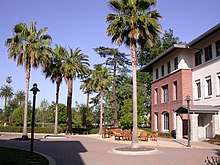List of Sun Microsystems employees
These notable people worked at Sun Microsystems at some point prior to its acquisition by Oracle Corporation.

A courtyard at the Sun main campus in Santa Clara, California
A
- Brian Aker, MySQL Director of Technology
- Ken Arnold, Sun Microsystems Laboratories, co-author of "The Java Programming Language"
B
- Carol Bartz, head of SunFed, Sun service and worldwide operations; Autodesk CEO, Yahoo! CEO
- Andy Bechtolsheim, Sun co-founder, systems designer and Silicon Valley investor
- Joshua Bloch, author of Effective Java
- Jon Bosak, chair of the original XML working group
- Jeff Bonwick, slab-allocator, vmem and ZFS
- Steve Bourne, creator of the Bourne shell
- Tim Bray, Director of Web Technologies
- David J. Brown, SUN workstation and Solaris
- Paul Buchheit, engineer at Sun from May 1997 to August 1997; Creator of Gmail
C
- Bryan Cantrill, of 2005 Technology Review "Top 35 Young Innovators", co-inventor of DTrace.
- Alfred Chuang, co-founder of BEA Systems
- Danny Cohen, co-creator of Cohen-Sutherland line clipping algorithms, coined the computer terms "Big Endians" and "Little Endians" (Endianness)
- Danese Cooper, Open Source specialist
D
- James Duncan Davidson, creator of the Tomcat web container and the Ant build tool
- L. Peter Deutsch, founder of Aladdin Enterprises and creator of Ghostscript
- Whitfield Diffie, Chief Security Officer, co-inventor of public-key cryptography
- Robert Drost, one of Technology Review's 2004 "Top 100 Young Innovators"
F
- Dan Farmer, computer security researcher
- Marc Fleury, creator of the JBoss application server
- Ned Freed, email systems researcher, co-author of several MIME RFCs
G
- Richard P. Gabriel, Lisp expert and founder of Lucid, Inc.
- John Gage, Chief Researcher and former Science Officer; first Sun salesman
- John Gilmore, co-founder of the Electronic Frontier Foundation and Cygnus Solutions
- James Gosling, co-inventor of Java; creator of NeWS networked extensible window system; author of first (proprietary) Unix Emacs implementation
- Todd Greanier, software architect, author and instructor
- Brendan Gregg, author of DTrace: Dynamic Tracing in Oracle Solaris, Mac OS X and FreeBSD, Systems Performance: Enterprise and the Cloud
J
K
- Vinod Khosla, Sun co-founder and Silicon Valley investor
L
- Susan Landau, mathematician and cybersecurity expert
- Adam Leventhal, co-inventor of DTrace
- Peter van der Linden, former manager of kernel group, author of numerous Java and C books
M
- Chris Malachowsky, co-founder of NVIDIA
- Clark Masters, EVP, Enterprise Systems and Father of the E10K, President of SunFed
- Craig McClanahan, creator or the Apache Struts framework and architect of Tomcat's servlet container, Catalina
- Scott McNealy, co-founder and Chairman of the Board of Sun; CEO from 1984-2006
- Larry McVoy, CEO of BitMover
- Björn Michaelsen, Director at The Document Foundation
- Mårten Mickos, CEO of MySQL AB from 2001 until Sun acquisition in 2008
- Jim Mitchell, Vice President and Sun Fellow
- Ian Murdock, Vice President of Developer and Community Marketing, founder of Debian
N
- Satya Nadella, CEO of Microsoft
- Patrick Naughton, co-creator of Java
- Jakob Nielsen, web-design usability authority
- Peter Norvig, Director of Research Google
O
- John Ousterhout, inventor of the Tcl scripting language
P
- Greg Papadopoulos, Executive Vice President and CTO
- Radia Perlman, sometimes known as the "Mother of the Internet"
- Simon Phipps, Chief Open Source Officer
- Kim Polese, prominent dot-com era executive
- Curtis Priem, co-founder of NVIDIA
R
- George Reyes, former CFO of Google, Inc.
- David S. H. Rosenthal, early X Window System developer and original designer of the ICCCM
- Wayne Rosing, project lead for the Apple Lisa; Sun hardware development manager and manager of Sun Labs
S
- Bob Scheifler, leader of X Window System development from 1984 to 1996
- Eric Schmidt, former Sun Chief Technology Officer, chairman and former CEO of Google, Inc., and co-developer of lex
- Jonathan I. Schwartz, former President and CEO of Sun
- Mike Shapiro, co-inventor of DTrace
- Bob Sproull, computer graphics pioneer
- Guy L. Steele, Jr., co-inventor of the Scheme programming language and member of IEEE standards committees of many programming languages
- Bert Sutherland, manager of Sun Labs, Xerox PARC, BBN Computer Science Division
- Ivan Sutherland, computer graphics pioneer
T
- Bruce Tognazzini, computer usability consultant
- Marc Tremblay, microprocessor architect and Sun's employee with the most awarded patents
- Bud Tribble, former VP of software development at NeXT, current VP of software technology at Apple
V
- Bill Vass, President and COO of Sun Microsystems Federal, Inc.
W
- Jim Waldo, lead architect of Jini
- Michael Widenius, original author of MySQL
Y
- William Yeager, software architect, inventor of the multi-protocol router.
Z
- Edward Zander, former President of Sun Microsystems; former CEO of Motorola
gollark: Fascinating.
gollark: Bow before my superior intellect, mortals.
gollark: Haven't we all?
gollark: I am not in any way selling or assisting in selling pizza and I DO NOT work for pizza companies in any form. This is NOT true. I have not in any way been sponsored by pizza companies. There have been no advertising agreements whatsoever with any companies producing pizza or otherwise to have me subliminally advertise pizza, as my profile picture is not a pizza. Since it is not a pizza, this is obviously not pizza advertisement whatsoever. No monetary exchanges or otherwise have occurred with companies engaged in pizza production for any reason relating to my profile picture. It's not pizza. There were no deals, under-the-table or otherwise, with pizza companies. No pizza companies pay for any kind of advertising involving me. I'm DEFINITELY not paid by pizza companies to do ANY pizza advertising or sales.
gollark: It is not pizza.
This article is issued from Wikipedia. The text is licensed under Creative Commons - Attribution - Sharealike. Additional terms may apply for the media files.